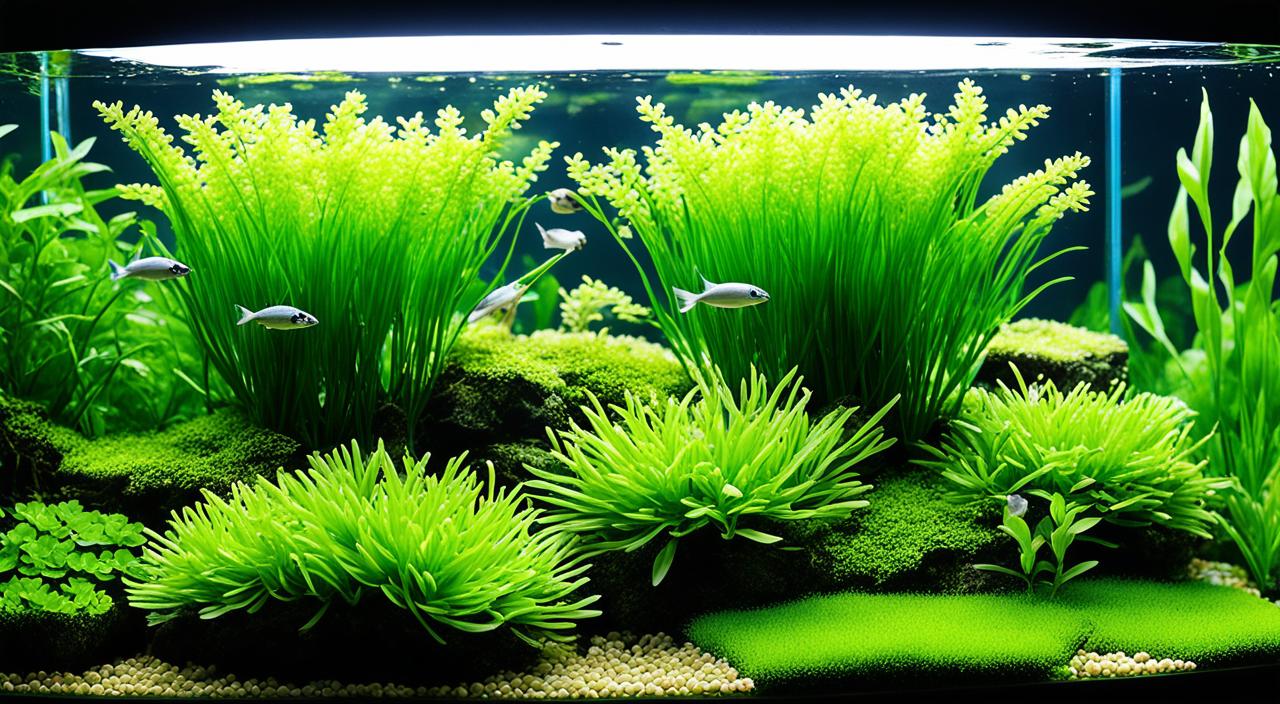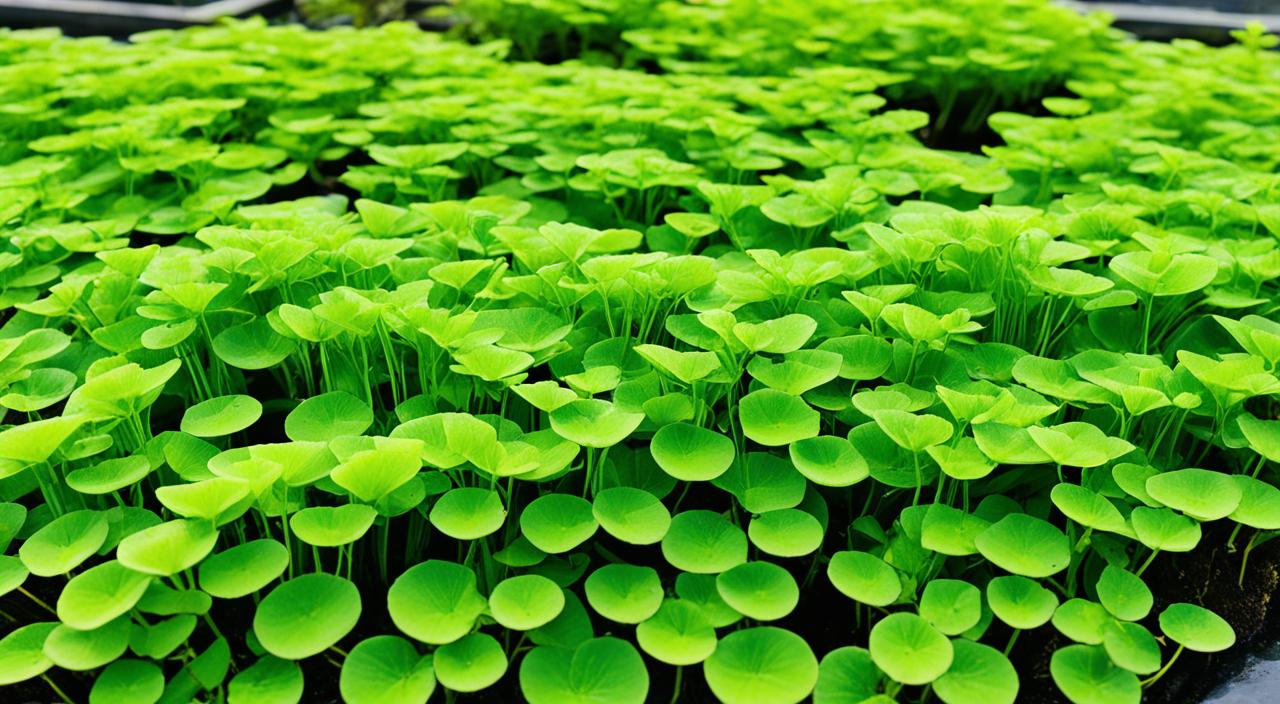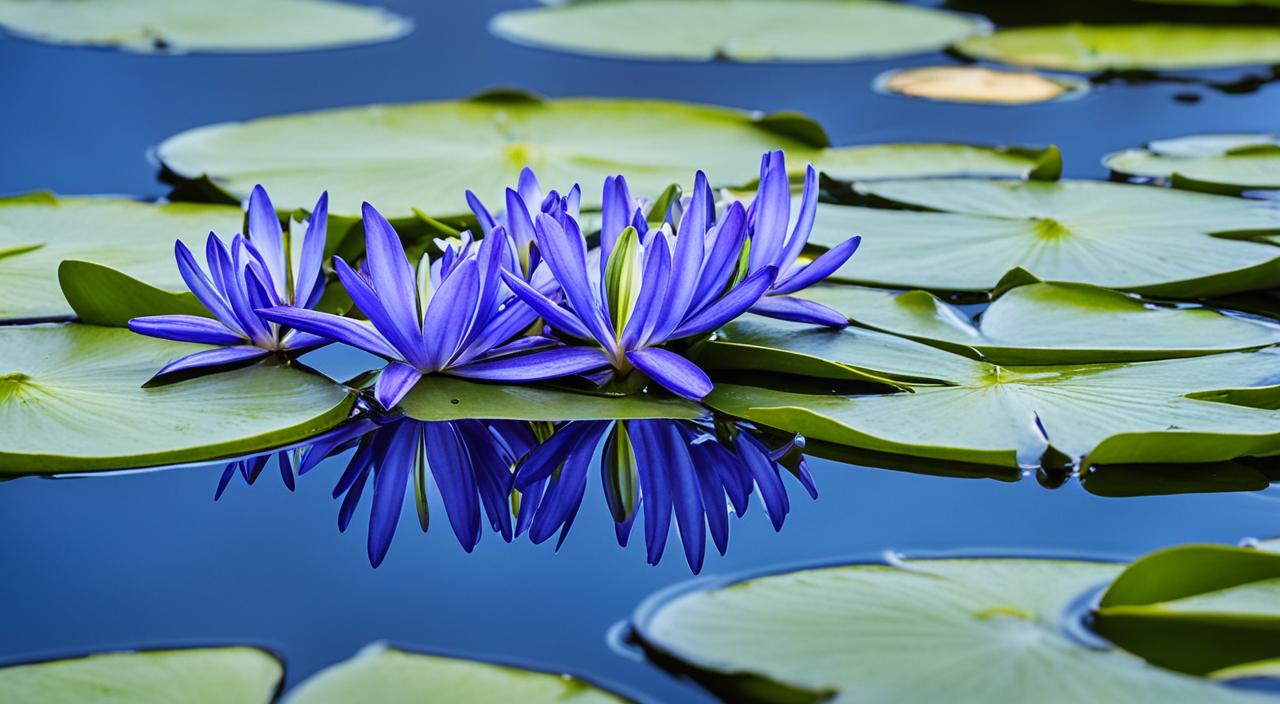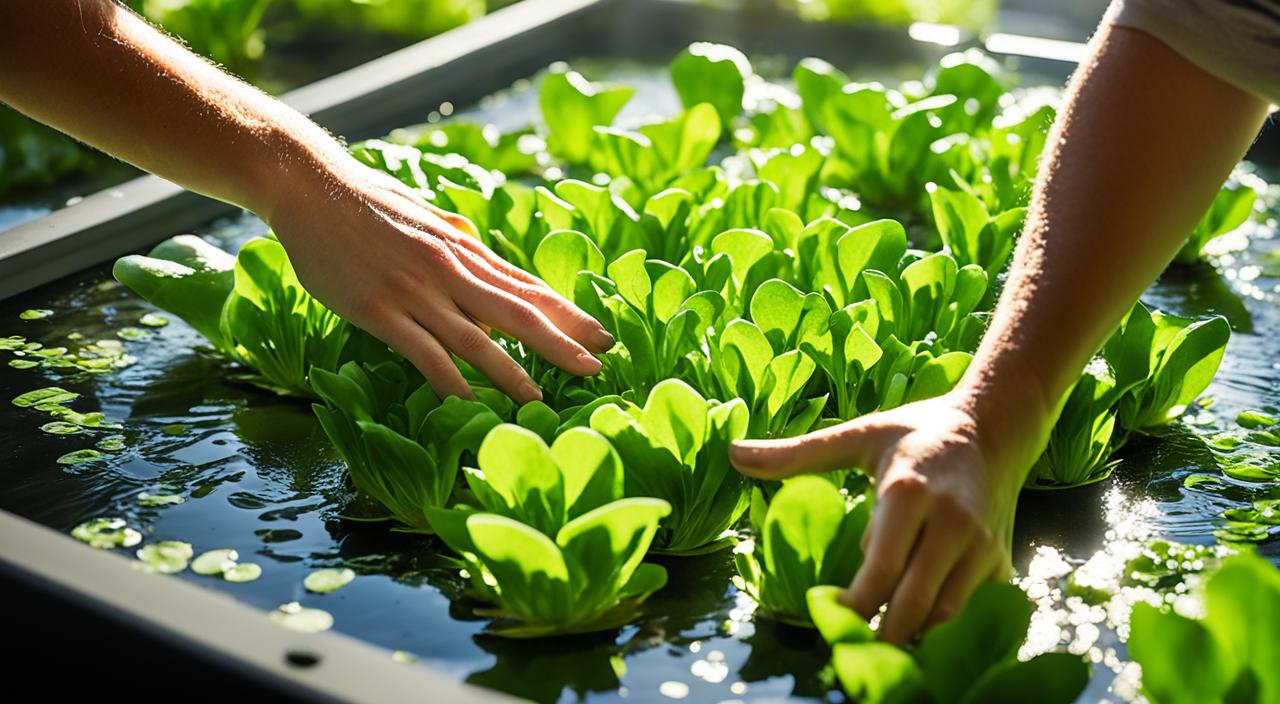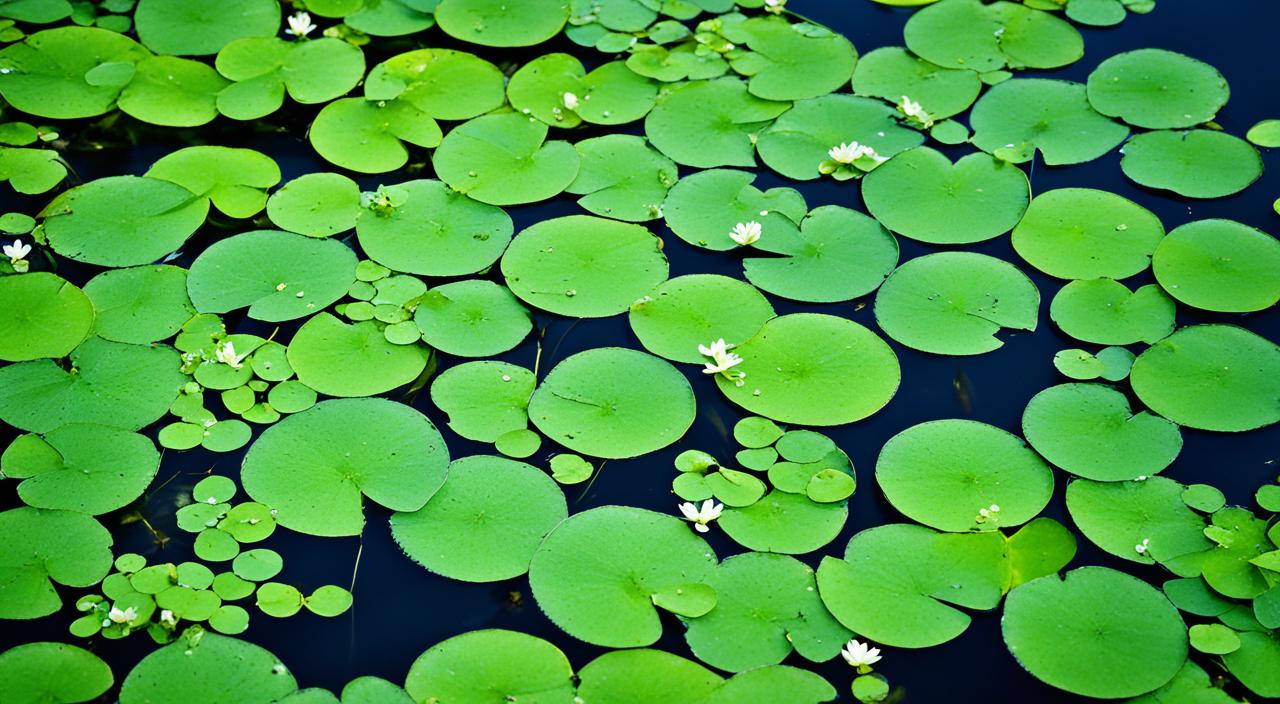G’day, mate! Today, I’m diving into the fascinating world of duckweed (Lemna minor), a versatile and beneficial plant perfect for your aquarium. Whether you’re a beginner or an experienced aquarist, this easy-to-care-for floating plant offers a range of advantages for your aquatic ecosystem.
Duckweed, also known as common duckweed or lesser duckweed, forms a dense, carpet-like cover on the water’s surface, adding a natural touch to your aquascape. But it’s not just about aesthetics – duckweed plays a crucial role in maintaining the health and balance of your tank.
With its ability to absorb excess nutrients from the water, duckweed acts as a natural filter, aiding in nitrate reduction and promoting cleaner water conditions for your aquatic inhabitants. This is excellent news for the overall well-being of your aquarium ecosystem.
Key Takeaways:
- Duckweed (Lemna minor) is a small floating plant that forms a dense cover on the water surface in your aquarium.
- It offers multiple benefits, including nutrient absorption, nitrate reduction, and providing shade and shelter for fish.
- Duckweed is easy to care for and can thrive in various aquatic environments.
- It adds a natural aesthetic to your aquascape and improves your tank’s overall health and balance.
- Incorporating duckweed into your aquarium creates a more vibrant and sustainable aquatic ecosystem.
Brief Overview Of Duckweed (Lemna minor)
Duckweed (Lemna minor) is a small aquatic plant that floats on the water’s surface. It has oval-shaped leaves and a single root that hangs in the water. Duckweed is known for its rapid growth and ability to colonize the surface of lakes and ponds, creating a dense mat of plants.
Information Table:
| Floats on water’s surface | Description |
|---|---|
| Scientific Name | Lemna minor |
| Common Names | Duckweed, Lesser Duckweed |
| Origin | Worldwide |
| Height | Floats on water surface |
| Growth Rate | Fast |
| Colour | Light green |
| Aquarium Placement | Water surface |
| Water Type | Freshwater |
| pH | 5.0 – 9.0 |
| Care Level | Easy |
| Light Requirements | Moderate to high. LUX: 2000-7000, PAR: 40-70 µmol/m²/s, Kelvin: 5000-7000K for optimal growth. |
| CO2 Requirements | Absorbs nutrients from the water; additional fertilization is not necessary but can promote growth. |
| Temperature | 50-86°F (10-30°C) |
| Flow Rate | Low to moderate; prefers stagnant to slow-moving water. |
| Propagation | Vegetative, through natural fragmentation. |
| Feed Type | Absorbs nutrients from the water; additional fertilization not necessary but can promote growth. |
The light requirements for Duckweed are pretty adaptable, but for optimal growth, a LUX range of 2000-7000, PAR values of 40-70 µmol/m²/s, and a Kelvin scale of 5000-7000K are recommended. These conditions mimic natural sunlight and promote healthy growth, ensuring that Duckweed effectively covers the water surface and absorbs excess nutrients from the water.
In aquariums, duckweed provides several benefits. It helps to reduce nitrate levels in the water by absorbing excess nutrients and acting as a natural filter. Duckweed provides shade and shelter for fish and other aquatic inhabitants, making it an excellent addition to any tank. It is an easy plant to care for and requires minimal maintenance, making it suitable for beginners and experienced aquarists.
Origins And Habitat
Duckweed (Lemna minor) is native to various regions, including Africa, Asia, Europe, and North America. It can be found in freshwater ponds, slow-moving streams, and other aquatic habitats. Duckweed thrives in nutrient-rich water and can quickly colonize the surface, forming dense mats. It is a versatile plant that can adapt to different water conditions, making it suitable for many aquarium setups.
Duckweed is commonly used in aquascaping to create a natural floating canopy and add visual interest to the tank.
Morphological Characteristics
Duckweed (Lemna minor) is characterized by its small, oval-shaped leaves, measuring 1-8 mm long. The leaves are light green in colour and feature three distinct veins. This floating plant gracefully rests on the water’s surface, with its delicate roots hanging beneath. A remarkable aspect of duckweed is its rapid vegetative reproduction, wherein it divides to form separate individuals, forming dense colonies under favourable conditions. Though the plant does produce small flowers, they are rarely observed in aquarium settings.
To better visualize the appearance of duckweed, refer to the image below:
Placement And Lighting
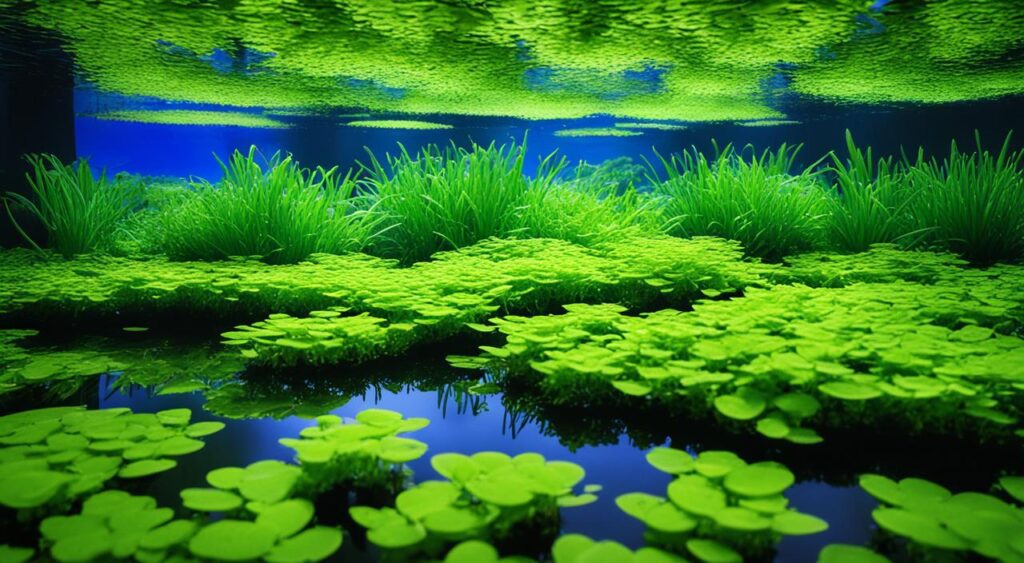
Duckweed (Lemna minor) is a versatile surface cover species that can be placed anywhere in the aquarium’s water surface. It will naturally float and spread across the tank, creating a beautiful carpet-like cover. However, it is essential to ensure that the duckweed does not entirely cover the entire surface of the water, as it needs some open space for gas exchange.
When it comes to lighting requirements, duckweed prefers bright, indirect lighting. It can tolerate many light intensities but does not do well in shallow light conditions. Moderate to high lighting will promote healthy growth and vibrant green colouration in the duckweed.
If the lighting is too intense, duckweed may grow more rapidly and require frequent pruning to prevent it from covering the entire tank surface. Balancing and adjusting the lighting intensity is vital to maintain optimal growth and aesthetic appeal.
| Placement | Lighting |
|---|---|
| Adjust lighting intensity to prevent rapid growth and surface coverage. | Prefer bright, indirect lighting |
| Avoid complete coverage of the water surface for gas exchange | Can tolerate a wide range of light intensities |
| Avoid shallow light conditions. | |
| Adjust lighting intensity to prevent rapid growth and surface coverage. | |
| Adjust lighting intensity to prevent rapid growth and surface coverage |
What Are Good Tank Mates?
Duckweed (Lemna minor) is a versatile aquatic plant that can coexist with various freshwater fish species and invertebrates, creating a harmonious and natural environment in your aquarium. Not only does duckweed provide cover and shade for fish, but it also offers several benefits for the overall health and balance of the tank. When choosing tank mates for duckweed, it is essential to consider their compatibility and behaviour to ensure the well-being of all inhabitants.
Good Tank Mates
Here are some examples of small, peaceful fish species that can thrive alongside duckweed:
- Guppies
- Tetras
- Rasboras
In addition to fish, duckweed can coexist with various invertebrates, including snails, shrimp, and other small aquatic creatures. These tank mates can benefit from the shade and shelter the duckweed provides, creating a natural and enriched habitat in your aquarium.
Fish Species To Avoid
While many fish species can happily coexist with duckweed, some are known to be herbivorous or prone to eating plants. It is advisable to avoid the following fish species as tank mates for duckweed:
- Goldfish
- Cichlids
These fish will likely devour duckweed, hindering its growth and overall presence in the tank.
It is essential to closely monitor the behaviour of your fish and ensure that they are not consuming excessive amounts of duckweed. If you notice any signs of overconsumption, consider adjusting the amount of duckweed in the tank or providing supplementary food options for your fish.
By selecting compatible tank mates and maintaining a balanced ecosystem, you can create a thriving and visually appealing aquarium environment with the benefits of duckweed.
Feeding (Fertilization)
Duckweed (Lemna minor) is an efficient nutrient absorber, obtaining most of its required nutrients from the water. Duckweed typically does not require additional fertilisation in a well-maintained aquarium with balanced water parameters. However, if you notice slow or pale growth, you can supplement its nutrient intake by adding a liquid fertilizer formulated explicitly for aquarium plants. Follow the manufacturer’s instructions for dosing and frequency to ensure proper fertilization. It is crucial to avoid over-fertilization, as excess nutrients can lead to algae growth and adversely affect water quality.
CO2 Injection
While Duckweed (Lemna minor) can thrive in aquariums without needing CO2 injection, supplementing with CO2 can promote faster growth and lush foliage, especially in heavily planted tanks with high light intensity.
Types
There are different methods of CO2 injection to consider when enhancing the growth of Duckweed in your aquarium. Here are three standard options:
- CO2 Canister with a Diffuser: This method involves using a canister filled with pressurized CO2, which is then diffused into the aquarium through a diffuser. The diffuser breaks down the CO2 into tiny bubbles, allowing efficient absorption by the Duckweed plants.
- CO2 Injection System: A CO2 injection system comprises a CO2 cylinder, regulator, and solenoid valve. It provides a more controlled release of CO2 into the aquarium, ensuring a consistent supply for optimal plant growth.
- Liquid Carbon Supplements: Liquid carbon supplements can be used as an alternative to CO2 injection. These supplements contain carbon compounds that the Duckweed can readily absorb. They are typically added directly to the aquarium water, following the product instructions for dosing.
When deciding on CO2 supplementation for your aquarium, consider the size of your tank, the specific needs of your plants, and your budget. It’s essential to find the right balance to support the growth of Duckweed and maintain a healthy aquatic environment.
| CO2 Injection Method | Pros | Cons |
|---|---|---|
| CO2 Canister with a Diffuser | Provides efficient CO2 delivery Allows controlled dosage Compatible with various tank sizes | Initial setup cost Refilling or replacing CO2 canisters |
| CO2 Injection System | Easy to use No special equipment is required Cost-effective option | Higher initial cost Requires additional equipment and maintenance |
| Liquid Carbon Supplements | Easy to use No special equipment required Cost-effective option | Offers precise control over CO2 dosage Ensures consistent CO2 supply Suitable for larger tanks with high-demand |
Care
Planted Tank Parameters
Duckweed (Lemna minor) is generally low-maintenance and can thrive in many aquarium conditions. However, providing optimal parameters will ensure the best growth and health of the plant. In a planted tank, it is important to consider the following parameters:
| Parameter | Ideal Range |
|---|---|
| Temperature | 20-26°C (68-78°F) |
| pH | 6.5-7.5 |
| Water Hardness | Moderate |
These parameters mimic the natural habitat of duckweed and provide optimal conditions for its growth. Regularly monitor and adjust these parameters to ensure the well-being of your duckweed and other aquatic inhabitants.
Water Quality
Maintaining good water quality is crucial to caring for duckweed and ensuring its health. Regular water changes are essential to remove accumulated toxins and maintain proper nutrient levels. Additionally, monitor ammonia, nitrite, and nitrate levels to prevent any imbalances that may affect the growth of your duckweed. Test kits are available to assess these parameters and guide your maintenance routine accurately.
Filtration
When choosing a filtration system for your planted tank, it is crucial to consider the needs of your floating duckweed. Gentle filtration is recommended to prevent disturbing the plants and their delicate root systems. Using a sponge filter or adjusting the flow rate of your filter can help maintain gentle water movement, ensuring the well-being of your duckweed.
Flow
Controlling the water flow in your aquarium is essential for duckweed’s proper growth and distribution. Avoid strong water currents that can displace the plants or create dead zones where debris can accumulate. Positioning the filter outlet away from the surface area with duckweed or using a diffuser to disperse water flow is recommended.
By providing the appropriate planted tank parameters, water quality, filtration, and flow, you can create an optimal environment for your duckweed to flourish and contribute to the overall beauty of your aquarium.
Aquarium Maintenance
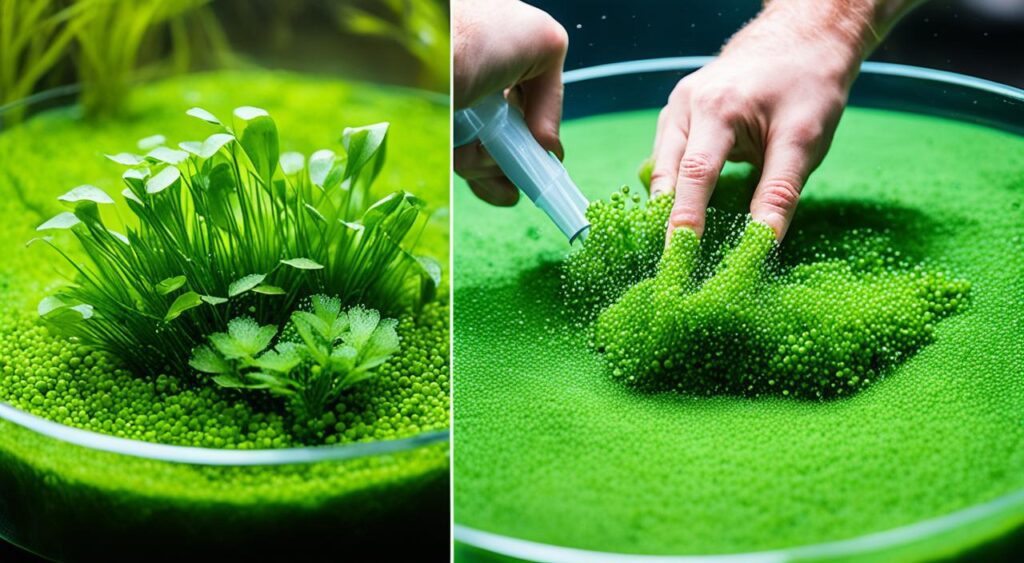
Testing Water Conditions
Regularly testing the water conditions in your aquarium is essential for maintaining the health and growth of duckweed (Lemna minor) and other aquatic inhabitants. Use a reliable test kit to monitor parameters such as ammonia, nitrite, nitrate, pH, and water hardness. By regularly testing these parameters, you can identify any potential issues and take appropriate actions to maintain optimal water quality, promoting the well-being of your aquarium ecosystem.
How To Set Up Your Aquarium Tank
When setting up your aquarium tank for duckweed, it is crucial to ensure the water is appropriately conditioned and free of chlorine or other harmful chemicals. Follow the instructions provided with your water conditioner to remove any potential toxins and make the water safe for your aquatic plants and animals. Additionally, provide adequate lighting for the tank to support photosynthesis and promote duckweed growth. Consider using a gentle water movement, such as an aquarium pump or filter, to keep the water well-oxygenated and prevent stagnant conditions that may negatively affect the plants.
Propagation Methods
Duckweed (Lemna minor) propagates easily through division, making it an efficient plant for rapid growth and colonization of the water surface. As duckweed reproduces, separate the individual plants, allowing them to float freely in the aquarium. With the right conditions, duckweed can quickly multiply, so it is important to regularly prune and remove excess plants to manage their growth and prevent them from covering the entire tank surface. By properly propagating and maintaining duckweed, you can ensure its steady growth and visual appeal in your aquarium.
Health And Disease
Duckweed (Lemna minor) is generally a hardy plant that is resilient against diseases. However, monitoring the plant’s health to catch any potential issues early on is crucial.
Signs Of Good Health
Signs of good health in duckweed include vibrant green colouration, rapid growth, and new leaf development. A healthy duckweed plant will have rich green leaves, indicating it receives enough nutrients and light to thrive. Rapid growth and the emergence of new leaves suggest the plant is thriving and adapting well to its environment.
Signs Of Poor Health
Signs of poor health in duckweed may include yellowing or browning of leaves, stunted growth, or decaying plant material. Yellow or brown leaves can indicate nutrient deficiencies or water quality issues. Stunted growth can be a sign of inadequate light or nutrient levels. Decaying plant material may indicate disease or contamination in the water.
Common Health Issues And Treatment
Common health issues affecting duckweed include nutrient deficiencies, algae overgrowth, and contamination from harmful substances in the water. Nutrient deficiencies can be addressed by providing a balanced fertilizer formulated explicitly for aquatic plants. Algae overgrowth can be controlled by maintaining proper water parameters, ensuring adequate water circulation, and adding algae-eating fish or invertebrates. Contamination issues can be mitigated by regularly monitoring water quality and conducting water changes when necessary.
Plant Pests
Duckweed is generally not prone to pest infestations. However, regularly inspecting the duckweed for pests like snails or insects is essential. If pests are detected, manually remove them from the tank to prevent damage to the plant.
| Common Health Issues | Treatment |
|---|---|
| Nutrient deficiencies | Provide balanced aquatic plant fertilizer |
| Algae overgrowth | Maintain proper water parameters, ensure adequate water circulation, and add algae-eating fish or invertebrates |
| Contamination | Regularly monitor water quality and conduct water changes when necessary |
Summary
In conclusion, incorporating Duckweed (Lemna minor) into your aquarium can bring numerous benefits and enhance the natural beauty of the tank. This floating aquatic plant is vital in reducing nitrate levels and absorbing excess nutrients, promoting a healthier environment for your aquatic inhabitants. Additionally, Duckweed provides shade and shelter, creating a more natural habitat for fish and other tank occupants.
One of the significant advantages of Duckweed is its ease of care. It is a low-maintenance plant that can thrive in various aquarium setups. Monitoring water parameters such as temperature, pH, and hardness ensures optimal growth. Providing suitable lighting conditions, neither too dim nor too intense, is vital to maintain vibrant green colouration and prevent excessive growth.
Regular maintenance and pruning are necessary to manage the growth of duckweed. While it reproduces quickly, it’s essential to prevent it from covering the entire tank surface. Additionally, carefully selecting tank mates is essential to avoid herbivorous fish species that may eat or damage the Duckweed. By following these care guidelines, you can enjoy the numerous benefits of Duckweed while maintaining a balanced and aesthetically pleasing aquarium.
FAQ
What are the benefits of having duckweed in an aquarium?
Duckweed aids in nitrate reduction, absorbs excess nutrients from the water, provides shade and shelter for aquatic inhabitants, and adds a natural aesthetic to the tank.
Is duckweed easy to care for?
Yes, duckweed is easy to care for, making it an ideal choice for both beginners and experienced aquarists.
Where is duckweed (Lemna minor) native to?
Duckweed is native to various regions, including Africa, Asia, Europe, and North America.
How does duckweed reproduce?
Duckweed mainly reproduces vegetatively by dividing and forming separate individuals. It can rapidly multiply, forming dense colonies if conditions are favorable.
Where should I place duckweed in my aquarium and what lighting does it require?
Duckweed can be placed anywhere on the water surface in the aquarium. It prefers bright, indirect lighting and can tolerate a wide range of light intensities.
What fish are good tank mates for duckweed?
Good tank mates for duckweed include small peaceful fish like guppies, tetras, and rasboras, as well as snails and shrimp. Avoid herbivorous fish species that may eat the duckweed.
Does duckweed require additional fertilization?
Duckweed does not typically require additional fertilization in a well-maintained aquarium. However, if growth appears slow or pale, you can supplement its nutrient intake with a liquid fertilizer formulated for aquarium plants.
Does duckweed require CO2 injection?
Duckweed can thrive without CO2 injection. However, supplementing with CO2 can promote faster growth and lush foliage, especially in heavily planted tanks with high light intensity.
What are the recommended water parameters for duckweed?
The recommended water parameters for duckweed are a temperature between 20-26°C (68-78°F), a pH of 6.5-7.5, and moderate water hardness.
How should I maintain my aquarium with duckweed?
Regular aquarium maintenance, including testing water conditions, providing proper lighting, managing duckweed growth, and monitoring water quality parameters, is essential for the health and well-being of the duckweed and other aquatic inhabitants.
Is duckweed prone to diseases or pests?
Duckweed is generally a hardy plant and resilient against diseases. However, it is important to monitor the health of the plant and watch out for pests such as snails or insects.
What are the key takeaways about duckweed?
Duckweed is an excellent addition to aquariums, providing numerous benefits and adding a natural aesthetic. It is easy to care for and can thrive in a variety of aquarium setups with proper maintenance. Regular pruning and management of growth are necessary to prevent it from covering the entire surface of the tank.

